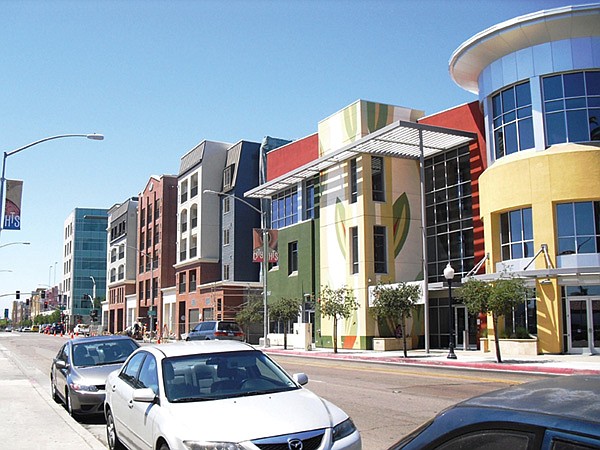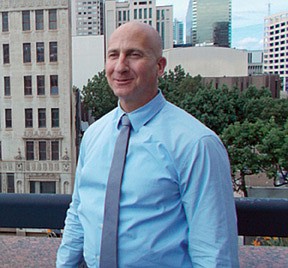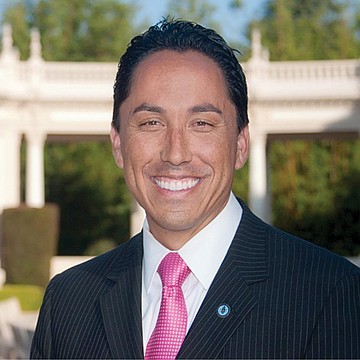 Facebook
Facebook
 X
X
 Instagram
Instagram
 TikTok
TikTok
 Youtube
Youtube

The Great Gatsby is forsaking his palatial estate, donning rags, and moving permanently into a run-down neighborhood. Huh? Well, something like that is happening in the City of San Diego. The city is entrusting Civic San Diego, essentially the successor to Centre City Development Corporation, with great responsibility over homelessness and affordable housing. Critics point out that Centre City, which in its heyday concentrated on gleaming high-end projects, was actually responsible for creating homelessness and was often contemptuous of affordable housing.
Civic San Diego is a combination of two scandal-plagued operations, the former Centre City and former Southeastern Economic Development Corporation. Centre City’s onetime head was fined by the Ethics Commission for failing to disclose her snug relationship with a developer — a cozy association that had been widely reported in Florida media before she was ever hired. Two Southeastern officials pleaded guilty to embezzlement but avoided the slammer.

It’s not a marriage of equals. Former players at Centre City dominate Civic San Diego. Four of its top five officials came over from Centre City, and the chairwoman has been involved in downtown intrigue for two decades. Civic San Diego’s 32 employees rake in an average $124,375 a year in salary and benefits.
On May 13, the city council approved the Affordable Housing Master Plan that would award Civic San Diego — author of the plan — $33 million to tackle affordable housing. Civic San Diego will also have some authority over the homeless problem, now the responsibility of the San Diego Housing Commission.
Centre City Development Corporation long had a reputation for hogging money for downtown projects that lined the pockets of developers.
Originally, California redevelopment was meant to rehabilitate blighted areas. But the concept was kidnapped and was used to subsidize projects that should have been financed with private capital — professional sports facilities, retail buildings, auto dealerships, movie theaters, and the like, in decidedly nonblighted areas. In San Diego, the money was concentrated downtown while neighborhoods and infrastructure crumbled. Critics put the blame where it belonged: on Centre City.
California has wisely killed redevelopment, along with its funding mechanism, tax-increment financing, by which tax revenues from additional surrounding growth is expected to pay costs of building a project. The Affordable Housing Master Plan is intended to keep redevelopment going under a different name, although new tax-increment financing and the city’s Redevelopment Agency are out of the picture.

Civil engineer Katheryn Rhodes likes the master plan but says Centre City “showed callousness toward the homeless” and contempt toward affordable housing. For example, in 2006, when downtown’s Hotel San Diego was torn down to make way for a federal courthouse, Centre City wouldn’t pick up the tab to relocate residents, thus sending some poor people into the streets. Consistently, “Centre City maintained that ‘homeless people are not a form of blight, so we can’t spend money on them.’ Instead, it would only spend money on brick-and-mortar projects,” mainly benefiting for-profit interests.
While claiming it helped low- and moderate-income citizens, Centre City “did a lousy job, choosing to deal with big money development downtown,” says Norma Damashek, former president of the League of Women Voters. But even that strategy didn’t work. Centre City “was supposed to kick-start private development” and then drop the handouts “while the private sector stepped in. But we are still relying on subsidies.”
She points out that when redevelopment turns a fleabag hotel into a boutique one, or knocks it down, homelessness is created. “Redevelopment displaces poor people,” she says, and Centre City exacerbated rather than alleviated that problem.
Robert Scott Dreher, an attorney in a lawsuit filed by Affordable Housing Advocates, points out that Centre City did not create new, commensurate housing for the dispossessed after bulldozing homes or hotels to subsidize a project assisting businesses.

Both Rhodes and anti-redevelopment activist Brian Peterson state that Centre City never spent 20 percent of tax-increment receipts on affordable housing, as required by law. Jeff Graham, president of Civic San Diego, disputes that, claiming Centre City reached its quota, and “those who continue to accuse [Centre City] of spending less than 20 percent of tax increment on affordable housing always neglected to count the debt service on the housing bonds.” The critics such as Rhodes and Damashek riposte that Centre City used accounting prestidigitation to claim it hit that 20 percent bogey.
A serious issue is possible duplicative bureaucracies. “It’s hard to kill an agency. You have to put a wooden stake through its heart,” says Steve Erie, political science professor at the University of California San Diego. Both Civic San Diego and the Housing Commission insist they can work happily together. But are they covering the same ground?
“Who is responsible for what?” asks Damashek. “Surely we shouldn’t be setting up another housing agency.” She says City of San Diego government is now dysfunctional as a result of bumbling by the prior administration, and she hopes mayor Bob Filner “will pull all these loose pieces together.”

Centre City “was often criticized for keeping all of the downtown tax-increment money downtown, yet the critics choose to ignore that it was illegal to do otherwise,” bristles Graham. Not so, says Rhodes. Monies from tax-increment financing downtown could have been used for the homeless or affordable housing outside of the downtown project area — “San Ysidro, for example,” she says.
Both Rhodes and Damashek point out that council president Todd Gloria pushed the council to approve Civic San Diego’s housing plan. Downtown is now in Gloria’s district. He “is courting the old-time powerhouses downtown by preserving what was Centre City,” says Damashek. “He has to court them for campaign money.”
Erie is concerned that Civic San Diego “will do a couple of showcase projects” in downtrodden areas “to demonstrate they are interested in more than downtown. But this may be a wolf in sheep’s clothing.”


The Great Gatsby is forsaking his palatial estate, donning rags, and moving permanently into a run-down neighborhood. Huh? Well, something like that is happening in the City of San Diego. The city is entrusting Civic San Diego, essentially the successor to Centre City Development Corporation, with great responsibility over homelessness and affordable housing. Critics point out that Centre City, which in its heyday concentrated on gleaming high-end projects, was actually responsible for creating homelessness and was often contemptuous of affordable housing.
Civic San Diego is a combination of two scandal-plagued operations, the former Centre City and former Southeastern Economic Development Corporation. Centre City’s onetime head was fined by the Ethics Commission for failing to disclose her snug relationship with a developer — a cozy association that had been widely reported in Florida media before she was ever hired. Two Southeastern officials pleaded guilty to embezzlement but avoided the slammer.

It’s not a marriage of equals. Former players at Centre City dominate Civic San Diego. Four of its top five officials came over from Centre City, and the chairwoman has been involved in downtown intrigue for two decades. Civic San Diego’s 32 employees rake in an average $124,375 a year in salary and benefits.
On May 13, the city council approved the Affordable Housing Master Plan that would award Civic San Diego — author of the plan — $33 million to tackle affordable housing. Civic San Diego will also have some authority over the homeless problem, now the responsibility of the San Diego Housing Commission.
Centre City Development Corporation long had a reputation for hogging money for downtown projects that lined the pockets of developers.
Originally, California redevelopment was meant to rehabilitate blighted areas. But the concept was kidnapped and was used to subsidize projects that should have been financed with private capital — professional sports facilities, retail buildings, auto dealerships, movie theaters, and the like, in decidedly nonblighted areas. In San Diego, the money was concentrated downtown while neighborhoods and infrastructure crumbled. Critics put the blame where it belonged: on Centre City.
California has wisely killed redevelopment, along with its funding mechanism, tax-increment financing, by which tax revenues from additional surrounding growth is expected to pay costs of building a project. The Affordable Housing Master Plan is intended to keep redevelopment going under a different name, although new tax-increment financing and the city’s Redevelopment Agency are out of the picture.

Civil engineer Katheryn Rhodes likes the master plan but says Centre City “showed callousness toward the homeless” and contempt toward affordable housing. For example, in 2006, when downtown’s Hotel San Diego was torn down to make way for a federal courthouse, Centre City wouldn’t pick up the tab to relocate residents, thus sending some poor people into the streets. Consistently, “Centre City maintained that ‘homeless people are not a form of blight, so we can’t spend money on them.’ Instead, it would only spend money on brick-and-mortar projects,” mainly benefiting for-profit interests.
While claiming it helped low- and moderate-income citizens, Centre City “did a lousy job, choosing to deal with big money development downtown,” says Norma Damashek, former president of the League of Women Voters. But even that strategy didn’t work. Centre City “was supposed to kick-start private development” and then drop the handouts “while the private sector stepped in. But we are still relying on subsidies.”
She points out that when redevelopment turns a fleabag hotel into a boutique one, or knocks it down, homelessness is created. “Redevelopment displaces poor people,” she says, and Centre City exacerbated rather than alleviated that problem.
Robert Scott Dreher, an attorney in a lawsuit filed by Affordable Housing Advocates, points out that Centre City did not create new, commensurate housing for the dispossessed after bulldozing homes or hotels to subsidize a project assisting businesses.

Both Rhodes and anti-redevelopment activist Brian Peterson state that Centre City never spent 20 percent of tax-increment receipts on affordable housing, as required by law. Jeff Graham, president of Civic San Diego, disputes that, claiming Centre City reached its quota, and “those who continue to accuse [Centre City] of spending less than 20 percent of tax increment on affordable housing always neglected to count the debt service on the housing bonds.” The critics such as Rhodes and Damashek riposte that Centre City used accounting prestidigitation to claim it hit that 20 percent bogey.
A serious issue is possible duplicative bureaucracies. “It’s hard to kill an agency. You have to put a wooden stake through its heart,” says Steve Erie, political science professor at the University of California San Diego. Both Civic San Diego and the Housing Commission insist they can work happily together. But are they covering the same ground?
“Who is responsible for what?” asks Damashek. “Surely we shouldn’t be setting up another housing agency.” She says City of San Diego government is now dysfunctional as a result of bumbling by the prior administration, and she hopes mayor Bob Filner “will pull all these loose pieces together.”

Centre City “was often criticized for keeping all of the downtown tax-increment money downtown, yet the critics choose to ignore that it was illegal to do otherwise,” bristles Graham. Not so, says Rhodes. Monies from tax-increment financing downtown could have been used for the homeless or affordable housing outside of the downtown project area — “San Ysidro, for example,” she says.
Both Rhodes and Damashek point out that council president Todd Gloria pushed the council to approve Civic San Diego’s housing plan. Downtown is now in Gloria’s district. He “is courting the old-time powerhouses downtown by preserving what was Centre City,” says Damashek. “He has to court them for campaign money.”
Erie is concerned that Civic San Diego “will do a couple of showcase projects” in downtrodden areas “to demonstrate they are interested in more than downtown. But this may be a wolf in sheep’s clothing.”
Comments